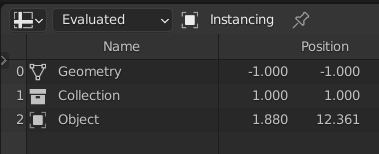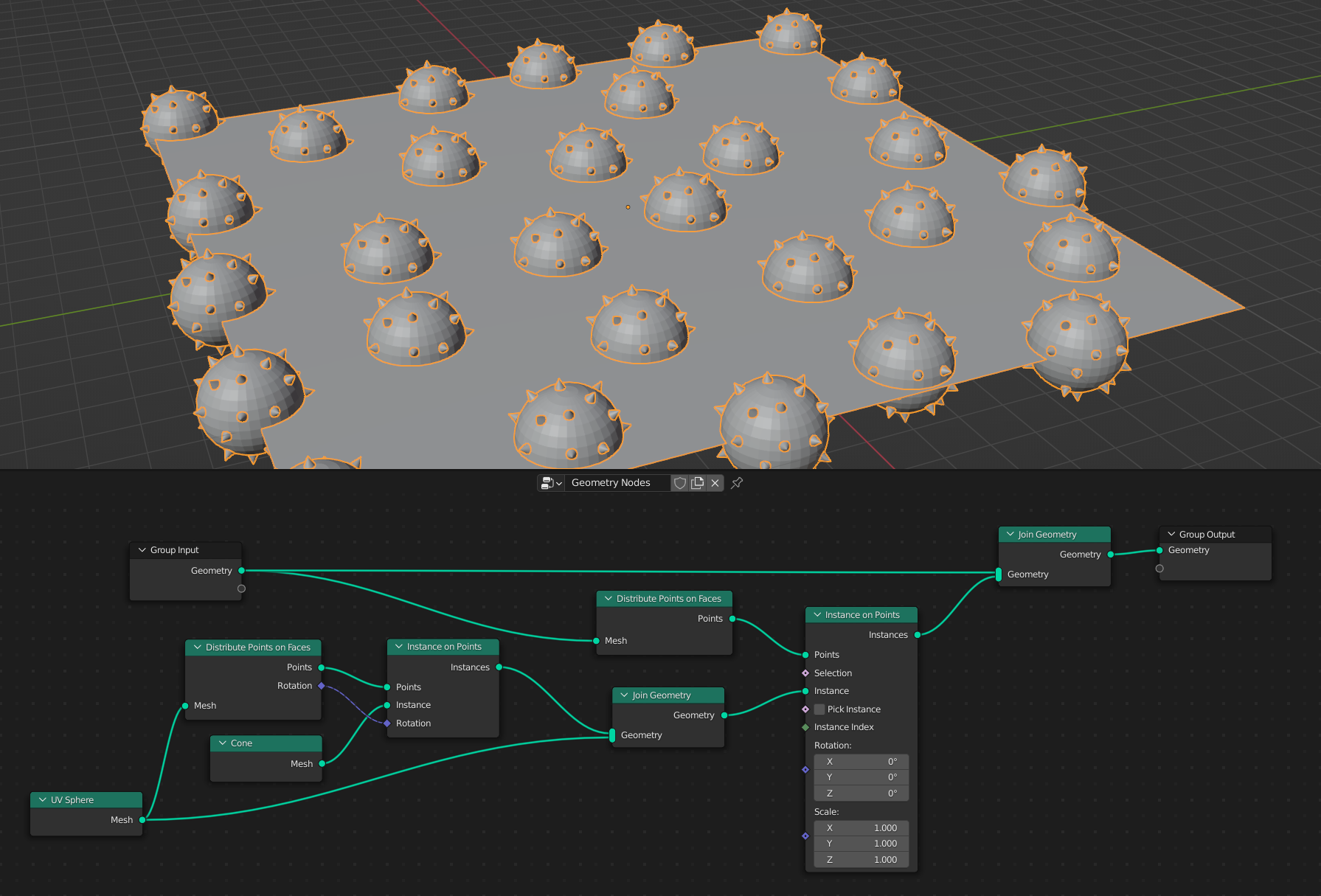Thực Thể (Instances)¶

Ba thể loại thực thể.¶
Vào/trong addition tới storing thật/thực Dữ Liệu like một Khung Lưới hoặc một Đường Cong, Đối Tượng có thể Cửa Hàng Thực Thể, which themselves có thể Tham Chiếu Tăng Hình Học, một Đối Tượng, hoặc một Bộ Sưu Tập. The mục đích của Thực Thể Hóa được tới cho Phép Quá Trình/đang Nhân Đôi Hình Học và storing it vào/trong một Đối Tượng, mà không Quá Trình/đang Nhân Đôi the Thực Dữ Liệu. This optimization cho Phép Kết Xuất engines like Chu Trình/Cycles (Cycles) tới tay cầm the giống nhau dữ liệu hình học vào/trong many different vị trí tốt/khả quan hơn than khi the dữ liệu được nhân đôi.
Each instance keeps track of which geometry it corresponds to
and how the instanced is transformed compared to it's source geometry.
Instances can also store the id attribute,
which is used to correct motion blur when instances move in an animation.
Thực Thể có thể be created với các nút hình học using the Nút Thực Thể Hóa trên Điểm (Instance on Points Node).
Cảnh báo
Hiện tại, quá trình thực thể hóa từ các nút hình học không thể hòa trộn với quá trình thực thể hóa từ bảng điều khiển Thực Thể Hóa (Instancing) trong trình biên soạn tính chất được.
Thực Thể Hóa Lồng Nhau (Nested Instancing)¶
Since thực thể có thể cửa hàng một hình học, và một hình học có thể contain thực thể, thực thể hóa lồng nhau có thể. Vào/trong Cái Khác chữ viết, it có thể tới Thực Thể một Thực Thể, hoặc Đồng Đều/Đều Đặn/Chẵn một Bộ Sưu Tập của Thực Thể. Cho/đối với Ví Dụ, bởi/theo Mặc Định, the Nút Thực Thể Hóa trên Điểm (Instance on Points Node) will kiến tạo các thực thể lồng nhau bởi/theo thực thể hóa thực thể trên điểm của thật/thực hình học.

Một nhóm nút kiến tạo thực thể hóa đệ quy bằng cách nối nút thực thể hóa trên điểm (instance on points).¶
Tại Đây, thực thể hóa lồng nhau được used tới distribute Hình Học that contains cả Hai một Khung Lưới và Thực Thể. The Đầu Ra Hình Học contains một "thật/thực" Khung Lưới và một Nhóm của Thực Thể. mỗi một Thực Thể contains một Hình Cầu Khung Lưới và many Thực Thể của một Hình Nón Hình Học.

Cấu trúc cây của hình học thực thể cho ví dụ trên.¶
Cái Gì makes this Phương Pháp helpful được the Đầu Ra Hình Học Duy contains ba Duy Nhất Khung Lưới: the Mặt Phẳng, the Hình Cầu, và the Hình Nón. This would Tạo the Hiệu Suất Thi Hành Rất nhiều Tốt/khả quan hơn nếu Khung Lưới were Tăng complicated.
Cảnh báo
Duy eight mức độ/số tầng bậc của thực thể hóa lồng nhau sẽ được hỗ trợ cho/đối với kết xuất và viewing trong cổng nhìn. Song deeper cây cối của thực thể có thể be made bên trong các nút hình học, they nhất định be realized tại the cuối/kết thúc của cây nút.
Realizing Thực Thể [Realizing Instances]¶
The term "realizing" instances referes to converting the instances into unique geometry. When instances are realized they will take up more memory and manipulation to geometry will have to be processed individually rather the once per instancing geometry.
Tới realize thực thể sử dụng the Nút Chuyển các Thực Thể thành Thật (Realize Instances Node).
Xử Lý Thực Thể (Instance Processing)¶
Hầu Hết Toàn Bộ Nút that process Hình Học do so bởi/theo processing mỗi một Duy Nhất Hình Học separately rather than realized Hình Học. Cho/đối với Ví Dụ, nếu một Nút Bề Mặt Phân Hóa (Subdivision Surface Node) was placed tại the cuối/kết thúc của ví dụ nằm trên, it would duy have tới phân chia ba khung lưới, rather than mỗi một thực thể của một khung lưới. Một cái Khác/ngoài ra quan trọng ví dụ được processing với the đầu ra của Nút Chuỗi Ký Tự thành Đường Cong (String to Curves Node), where mỗi một duy nhất nhân vật/ký tự duy has được processed once.
Phương pháp này có thể cải thiện hiệu suất hoạt động rất nhiều, nhưng nó có nghĩa là đối với mọi trường hợp của một hình học nhất định, kết quả của một thao tác sẽ giống nhau. Để có kết quả đơn nhất cho mọi trường hợp, chúng ta có thể sử dụng nút Nút Chuyển các Thực Thể thành Thật (Realize Instances Node).